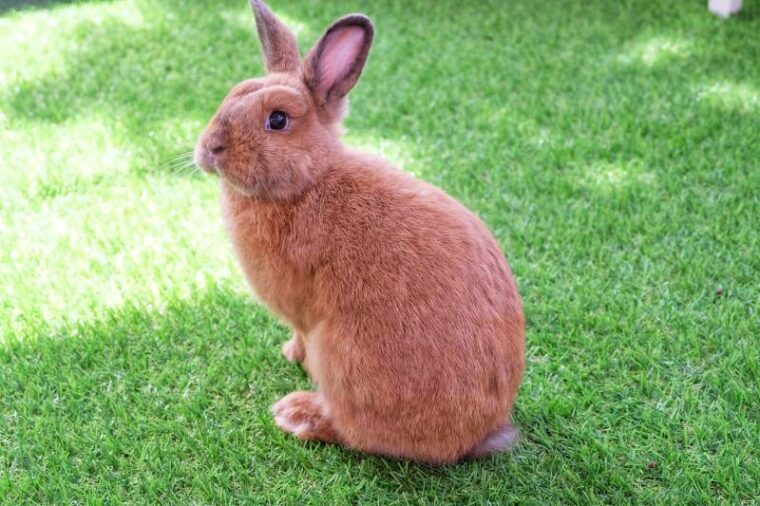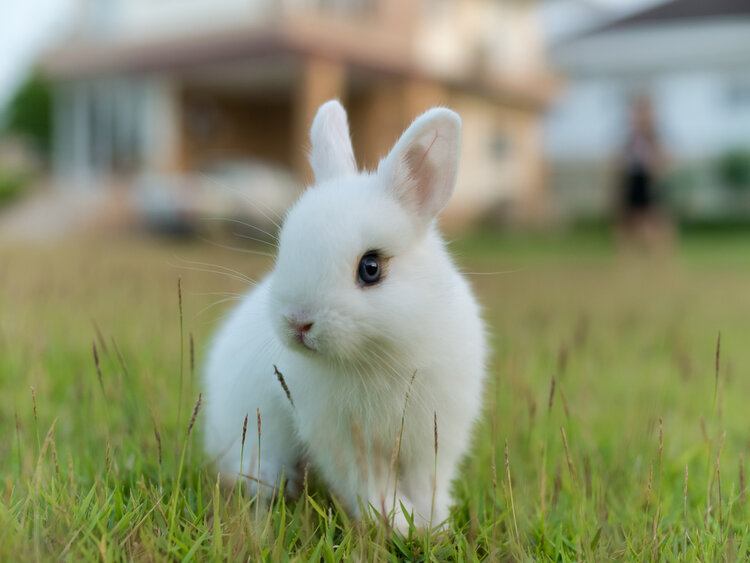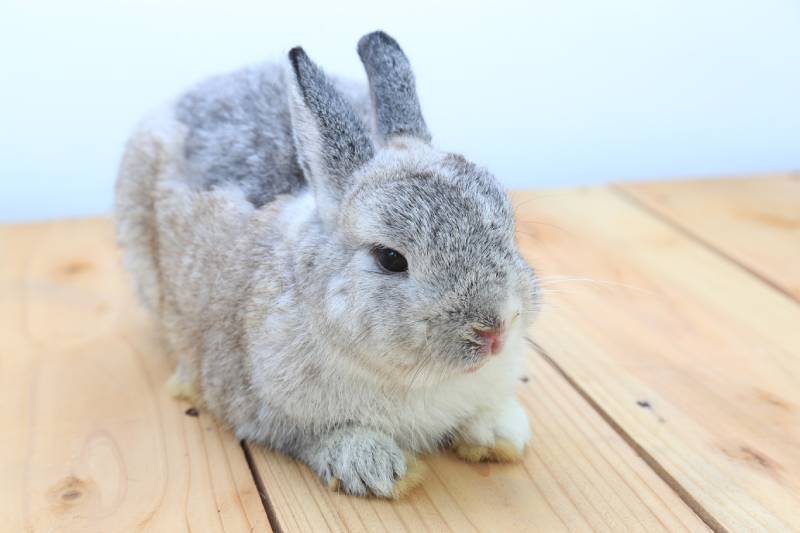
Click to Skip Ahead
Tiny, adorable, and intelligent, the Netherland Dwarf is a hugely popular breed among those looking for a show rabbit, as well as anyone looking for a new, compact house pet. In this post, we’ll tell you everything you need to know about the lively Netherland Dwarf Rabbit so you can decide if it’s the right pet for you!
Breed Overview
Size:
Dwarf
Weight:
Up to 3 pounds
Lifespan:
7–10 years
Similar Breeds:
Jersey Wooly, Dutch, Holland Lop, Polish Rabbit
Suitable for:
Families with older children, anyone looking for a small breed
Temperament:
Shy, excitable, lively
Weighing on average between 1 and 2.5 pounds, Netherland Dwarf Rabbits are one of the smallest breeds of rabbits around. The American Rabbit Breeders Association recognizes this adorable breed, and its unique traits, including its variety of colors, compact size, and brachycephalic head, have helped it become a popular show rabbit.
But Netherland Dwarfs aren’t just for show. Their compact size makes them an excellent pet for people who live in apartments and small, quiet homes—as long as they can provide their rabbit with a chance to run around each day.
Despite their friendly nature, Netherland Dwarf Rabbits are shy at first. These tiny rabbits are quite fragile and don’t enjoy being picked up, so they wouldn’t be a good fit for homes with young children. However, for adult couples or single people living in a quiet home, a Netherland Dwarf Rabbit can quickly establish their place as a favorite, new fluffy companion!
Netherland Dwarf Rabbit Breed Characteristics
How Much Do These Rabbits Cost?
These rabbits were originally developed in the Netherlands by a group of Dutchmen led by Jan Meyering. By crossbreeding Polish rabbits with smaller, local wild rabbits, the team set out to create a small, standardized show breed that would be available in many colors.
By the mid-1960s, Netherland Dwarf Rabbits were introduced to the U.S., and due to their charming size and gentle temperament, they quickly became one of the most popular pet rabbit breeds in the country.
Thanks to this popularity, a Netherland Dwarf Rabbit could cost between $25 and $100. But if you’re bringing a pet Netherland Dwarf Rabbit home, it’s also important to factor in other costs. For example, you’ll need to purchase a hutch, straw, and food. Your rabbit will also need grooming and veterinary care, so don’t forget to compare veterinarian prices in your area and look into pet insurance.
Temperament & Intelligence of the Netherland Dwarf Rabbit
Do These Rabbits Make Good Pets? 👪
Netherland Dwarf Rabbits are an intelligent, clean, lively breed of bunnies that make excellent pets—for the right people. These rabbits are known to be a little shy and reserved, especially when first introduced to new people and new homes. You’ll need to give them time and lots of space to gain the confidence they need to come out and meet you.
It’s also important to remember that their pint-sized cuteness makes them fragile, and they especially don’t like to be picked up—something that may make them nip and scrabble out of panic, which can result in them getting dropped and injured.
Their small size and shy nature mean that Netherland Dwarf Rabbits are not advisable for homes with small children. Instead, these rabbits do best in quiet homes with seniors, single adults, couples, or families with older children.
Once properly socialized, Netherland Dwarf Rabbits can be trained to use a litter box, run agility courses, fetch, jump, spin, and perform a bunch of other tricks.

Does This Rabbit Get Along With Other Pets?
These rabbits are generally sociable and should take well to other pets, especially other rabbits and guinea pigs. It is possible for them to get along with some well-mannered dogs (breeds with a low prey drive) and even house cats, though you’ll need to make sure you monitor all their interactions!
The critical thing to remember is that rabbits are prey, while cats and dogs are predators. The Netherland Dwarf Rabbit is naturally a small and shy breed that will try to run away and hide, but this, in turn, can trigger a cat’s instinct to hunt. Make sure you socialize with your pets while they are all young, and never leave them unattended in the same room.
Things to Know When Owning a Netherland Dwarf Rabbit:
Food & Diet Requirements 🥕
A healthy, good-quality diet is crucial for the overall health of your Netherland Dwarf Rabbit. While good-quality timothy hay will make up the bulk of your bunny’s diet, you’ll also need to provide them with a small amount of fresh, leafy green vegetables every day.
You can also supplement your rabbit’s diet with a small amount of pellets, though you should try to ensure the brand you choose is high in fiber and doesn’t contain artificial sugar or coloring.
Hutch Requirements 🏠
If you are keeping your rabbit inside the house, you’ll need to provide them with a hutch that is four times their body’s length and tall enough that they can stand on their hind legs without bumping their head. Remember, if you have a young rabbit, you should consider its future adult size when buying the hutch.
Considering the average size of a Netherland Dwarf Rabbit, a hutch that is 40 inches long, 20 inches wide, and 12 inches tall should be adequate as long as your rabbit has the opportunity to come out and run around for more than an hour each day.
If you plan on keeping them in the hutch, they’ll need a run or a larger cage—preferably with multiple stories—to prevent them from getting bored.

Exercise & Sleeping Needs 🐇
In the wild, rabbits run for several miles every day. Your Netherland Dwarf Rabbit will need daily exercise to keep them from becoming obese and to prevent them from getting bored and depressed. They should have plenty of space to hop around, sniff, and explore.
Providing them with a large enclosure and enrichment toys, such as tunnels, balls, and chew toys, will make your bun very happy.
When it comes to sleep, rabbits are most active during dawn and dusk, and they tend to nap throughout the day. If your bunny is in an enclosure, make sure there is a wire mesh on the base and high fences to protect them from predators. Ensure that at least part of the enclosure is in a spot sheltered from both rain and direct sunlight.
Training 🥎
Training your rabbit is a wonderful way to strengthen the bond between you and your pet. Aside from the joy you’ll feel once you get them using a litter box, coming to you when called, and performing tricks, you’ll also do your pet a massive favor by keeping them mentally stimulated, and, therefore, happier.
You can use treats and positive reinforcement to help your bunny learn new tricks. Once they’ve mastered the basics, you can even get them running agility courses!

Grooming ✂️
Netherland Dwarf Rabbits will need brushing regularly to help remove debris, prevent matting, and remove loose hair. Your rabbit may be shy at first, but with gentle socialization, they’ll learn to enjoy it.
As well as brushing, a Netherland Dwarf Rabbit’s nails will need regular trimming. Left to grow too long, it can cause them pain and discomfort.
Lifespan and Health Conditions 🏥
Netherland Dwarf Rabbits have a good average lifespan of 7 to 10 years. With a healthy diet, plenty of exercise, and good care, these pets shouldn’t have many health issues. That said, like all animals, they are prone to a few health issues—some related to their tiny builds.

3 Little-Known Facts About the Netherland Dwarf Rabbit
1. Netherland Dwarf Rabbits were officially recognized in the Netherlands in 1940, just days before Nazi Germany occupied the country.
2. By the end of World War II, only 17 Netherland Dwarf Rabbits remained in the world.
3. These rabbits can be recognized by their round, compact bodies, brachycephalic heads, and short ears that stick up instead of flopping over.
Final Thoughts
Naturally shy and fragile, these rabbits aren’t suitable for homes with small children. However, if you’re looking for a pint-sized, fluffy bundle of energy and can provide a quiet home, then the Netherland Dwarf Rabbit may be the perfect breed for you. With enough time and patience, Netherland Dwarf Rabbits become a lively companion, perfect for training and spending time with!
- Related reads: 10 Most Affectionate Rabbit Breeds (With Pictures)
Featured Image Credit: WACH1, Shutterstock








